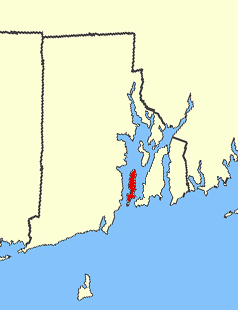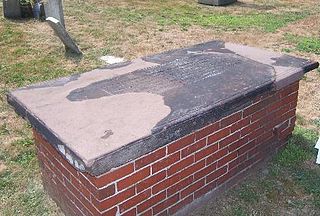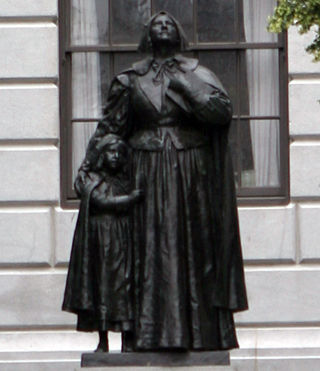Related Research Articles

Roger Williams was an English-born New England Puritan minister, theologian, and author who founded Providence Plantations, which became the Colony of Rhode Island and Providence Plantations and later the State of Rhode Island. He was a staunch advocate for religious freedom, separation of church and state, and fair dealings with the Native Americans.

King Philip's War was an armed conflict in 1675–1676 between a group of indigenous peoples of the Northeastern Woodlands and the English New England Colonies and their indigenous allies. The war is named for Metacomet, the Pokanoket chief and sachem of the Wampanoag who adopted the English name Philip because of the friendly relations between his father Massasoit and the Plymouth Colony. The war continued in the most northern reaches of New England until the signing of the Treaty of Casco Bay on April 12, 1678.

The Pequot War was an armed conflict that took place in 1636 and ended in 1638 in New England, between the Pequot tribe and an alliance of the colonists from the Massachusetts Bay, Plymouth, and Saybrook colonies and their allies from the Narragansett and Mohegan tribes. The war concluded with the decisive defeat of the Pequot. At the end, about 700 Pequots had been killed or taken into captivity. Hundreds of prisoners were sold into slavery to colonists in Bermuda or the West Indies; other survivors were dispersed as captives to the victorious tribes.

The Narragansett people are an Algonquian American Indian tribe from Rhode Island. Today, Narragansett people are enrolled in the federally recognized Narragansett Indian Tribe. They gained federal recognition in 1983.

Aquidneck Island, officially known as Rhode Island, is an island in Narragansett Bay in the state of Rhode Island. The total land area is 37.8 sq mi (98 km2), which makes it the largest island in the bay. The 2020 United States Census reported its population as 60,109. The state of Rhode Island is named after the island; the United States Board on Geographic Names recognizes Rhode Island as the name for the island, although it is widely referred to as Aquidneck Island in the state and by the island's residents.

Conanicut Island is an island in Narragansett Bay in the American state of Rhode Island. The second-largest in the Bay, it is connected on the east to Newport on Aquidneck Island by the Claiborne Pell Bridge, commonly known as the Newport Bridge, and on the west to North Kingstown on the mainland via the Jamestown-Verrazano Bridge. The town of Jamestown comprises the entire island. The U.S. Census Bureau reported a land area of 24.46 km2 (9.44 sq mi) and a population of 5,622 in 2000. A tombolo connects the southern part of Conanicut to an extension of the island to the southwest.

John Clarke was a physician, Baptist minister, co-founder of the Colony of Rhode Island and Providence Plantations, author of its influential charter, and a leading advocate of religious freedom in America.

Ninigret was a sachem of the eastern Niantic Indian tribe in New England at the time of colonization, based in Rhode Island. In 1637, he allied with the colonists and the Narragansetts against the Pequot Indians.

Benedict Arnold was president and then governor of the Colony of Rhode Island and Providence Plantations, serving for a total of 11 years in these roles. He was born and raised in the town of Ilchester, Somerset, England, likely attending school in Limington nearby. In 1635 at age 19, he accompanied his parents, siblings, and other family members on a voyage from England to New England where they first settled in Hingham in the Massachusetts Bay Colony. In less than a year, they moved to Providence Plantation at the head of the Narragansett Bay at the request of Roger Williams. In about 1638, they moved once again about five miles (8 km) south to the Pawtuxet River, settling on the north side at a place commonly called Pawtuxet. Here they had serious disputes with their neighbors, particularly Samuel Gorton, and they put themselves and their lands under the jurisdiction of Massachusetts, a situation which lasted for 16 years.

The Great Swamp Massacre or the Great Swamp Fight was a crucial battle fought during King Philip's War between the colonial militia of New England and the Narragansett people in December 1675. It was fought near the villages of Kingston and West Kingston in the Colony of Rhode Island and Providence Plantations. The combined force of the New England militia included 150 Pequots, and they inflicted a huge number of Narragansett casualties, including many hundred women and children. The battle has been described as "one of the most brutal and lopsided military encounters in all of New England's history." Since the 1930s, Narragansett and Wampanoag people commemorate the battle annually in a ceremony initiated by Narragansett-Wampanoag scholar Princess Red Wing.
Tobias Saunders was a Deputy to the Rhode Island General Assembly, a Conservator of the Peace and a founding settler of Westerly, Rhode Island.
Edward Hutchinson (1613–1675) was the oldest child of Massachusetts and Rhode Island magistrate William Hutchinson and his wife, the dissident minister Anne Hutchinson. He is noted for making peace with the authorities following his mother's banishment from the Massachusetts Bay Colony during the Antinomian Controversy, returning to Boston, and ultimately dying in the service of the colony that had treated his family so harshly.

Major-General Humphrey Atherton, an early settler of Dorchester, Massachusetts, held the highest military rank in colonial New England. He first appeared in the records of Dorchester on March 18, 1637 and made freeman May 2, 1638. He became a representative in the General Court in 1638 and 1639–41. In 1653, he was Speaker of the House, representing Springfield, Massachusetts. He was chosen assistant governor, a member of the lower house of the General Court who also served as magistrate in the judiciary of colonial government, in 1654, and remained as such until his death." He was a member of the Ancient and Honorable Artillery Company of Massachusetts and held the ranks of lieutenant and captain for several years before rising to the rank of major-general. He also organized the first militia in Massachusetts.
Stukely Westcott was one of the founding settlers of the Colony of Rhode Island and Providence Plantations and one of the original members of the first Baptist Church in America, established by Roger Williams in 1638. He came to New England from the town of Yeovil in Somerset, England and first settled in Salem in the Massachusetts Bay Colony, but difficulties with the authorities prompted him to join Roger Williams in settling near the Narragansett Bay in 1638 at Providence Plantations. He remained there for a few years, but he was recorded as an inhabitant of Warwick in 1648, probably having settled there several years earlier. He was most active in colonial affairs from 1650 to 1660 when he was a commissioner, surveyor of highways, and the keeper of a house of entertainment. His highest offices were as an Assistant in 1653 and much later as a deputy to the General Court in 1671 when he was almost 80 years old. He made his will on January 12, 1677, but died the same day with it unsigned, leaving his affairs in limbo for the following two decades.

Samuel Wilbore was one of the founding settlers of Portsmouth in the Colony of Rhode Island and Providence Plantations. He emigrated from Essex, England to Boston with his wife and three sons in 1633. He and his wife both joined the Boston church, but a theological controversy began to cause dissension in the church and community in 1636, and Wilbore aligned himself with John Wheelwright and Anne Hutchinson, signing a petition in support of dissident minister Wheelwright. In so doing, he and many others were disarmed and dismissed from the Boston church. In March 1638, he was one of 23 individuals who signed a compact to establish a new government, and this group purchased Aquidneck Island, then known as "Rhode Island", from the Narragansett Indians at the urging of Roger Williams, establishing the settlement of Portsmouth.
Randall Holden was an early inhabitant of the Colony of Rhode Island and Providence Plantations, one of the original founders of Portsmouth, and one of the co-founders of the town of Warwick. He came to New England from Salisbury, Wiltshire, England and is first recorded as one of the signers of the Portsmouth Compact. Following a few years on Aquidneck Island, he joined Samuel Gorton and ten others to establish the town of Warwick in early 1643 on land purchased from the Indian sachems.
Richard Smith (1596–1666) was the first European settler in the Narragansett country in the Colony of Rhode Island and Providence Plantations. He established a trading post on the western side of the Narragansett Bay at a place called Cocumscussoc which became the village of Wickford in modern-day North Kingstown, Rhode Island.

Susanna Cole was the lone survivor of an American Indian attack in which many of her siblings were killed, as well as her famed mother Anne Hutchinson. She was taken captive following the attack and held for several years before her release.
Robert Coles was a 17th-century New England colonist who is known for the scarlet-letter punishment he received in the Massachusetts Bay Colony and his role in establishing the Providence Plantations, now the state of Rhode Island.
References
- ↑ Chandler, Alfred N. (2010). Land Title Origins: A Tale of Force and Fraud by Alfred N. Chandler. Beard Books. ISBN 9781893122895.
- ↑ Holmes, Abiel (1829). "The Annals of America: From the Discovery by Columbus in the Year 1492 to 1826 Volume 2".
- ↑ "America and West Indies: March 1665. Calendar of State Papers Colonial, America and West Indies: Volume 5, 1661-1668". british-history.ac.uk. Her Majesty's Stationery Office, London. 1880. pp. 284–289.
- ↑ Brooks, Lisa. "Our Beloved Kin: Remapping A New History of King Philip's War".
- ↑ Potter, Elisha R. (1879). Memoir Concerning the French Settlements and French Settlers in the Colony of Rhode Island. Providence: Sidney S. Rider. pp. 19–21.
- ↑ "Proceedings of the Rhode Island Historical Society 1881-1882" (PDF). Rhode Island Historical Society.
- ↑ Ellis, George E.; Winthrop, Robert C.; Green, Samuel A.; Channing, Edward; Deane, Charles (1885). "November Meeting, 1885. Washington Monument; The Beadle Tablet; Atherton Company." Proceedings of the Massachusetts Historical Society 2 (1885): 136-53". Massachusetts Historical Society. pp. 150–153. JSTOR 25079641.
- ↑ "pettaquamscutt-rock and claim by Atherton Trading Company". Online Review of Rhode Island History.
- ↑ "Narragansett History referring to the Atherton purchases". www.narragansettri.gov/368/Early-History.
- ↑ Martin, John Frederick (1991). a Profits in the Wilderness: entrepreneurship and the founding of New England towns in the seventeenth century. UNC Press Books. p. 62,80,100,164. ISBN 9781469600031.
- ↑ Dunn, Richard S. (8 December 2015). Puritans and Yankees: The Winthrop Dynasty of New England 1630-1717 by Richard S. Dunn. Princeton University Press. ISBN 9781400878727.
- ↑ Anthony, Craig (2017). King's Province: Samuel Teffts Narrative of the Narraganset Country by Craig Anthony. ISBN 9781387474370.
- ↑ "The Names of the chief Proprietors of the lands of the Narragansett, Niantica, and Cowesett countries, chosen and admitted by Major Humphrey Atherton".
- ↑ Parsons, Charles William (1887). "First mayor of New York city, Thomas Willett". Magazine of American history for March.
- ↑ Martin, John Frederick. Profits in the Wilderness: entrepreneurship and the founding of New England towns in the seventeenth century. UNC Press Books. 1991 p. 306
- ↑ Arnold, James N. (James Newell); Fones, John (1894). "The records of the proprietors of the Narragansett : otherwise called the Fones record".
- ↑ Bowen, Clarence Winthrop (1882). "The boundary disputes of Connecticut". Boston, J. R. Osgood and company. pp. 31–34, 38–39, 41.
- ↑ Cole, J R (January 1889). "History of Washington and Kent counties, Rhode Island, including their early settlement".
- ↑ "To the Honourable the committee appointed to receive claims of such as have right and propriety in the Narraganset Country, or Kings province, in New-England. The declaration of claim in the name and behalf of the proprietors, and owners". Library of Congress. 1708. pp. 1–2.
- ↑ Cole, J. R. (1889). "History of Washington and Kent Counties, Rhode Island". W.W.Preston & Co., New York.
- ↑ Richardson, James Daniel (1908). "U.S. President - A Compilation of the Messages and Papers of the Presidents 1789-1908 Vol. XI". Bureau of National Literature and Art. p. 301.